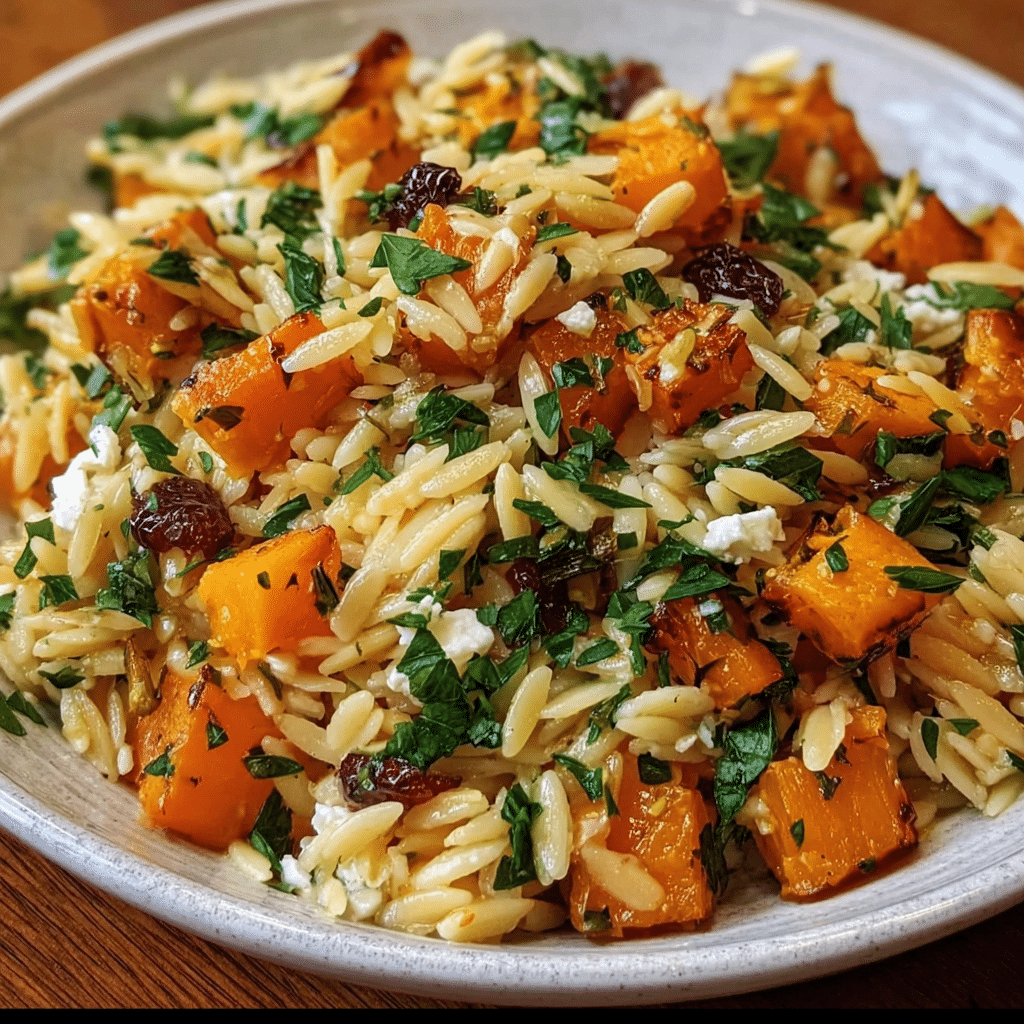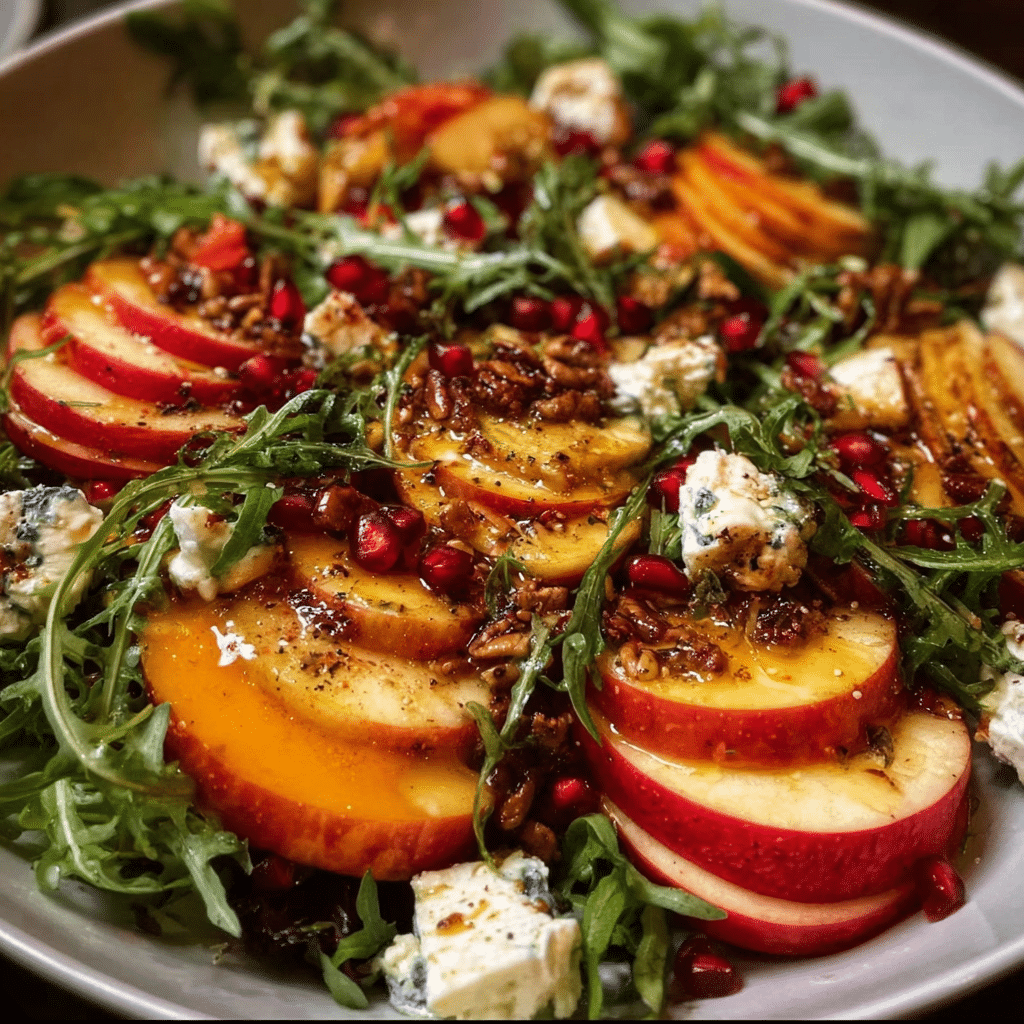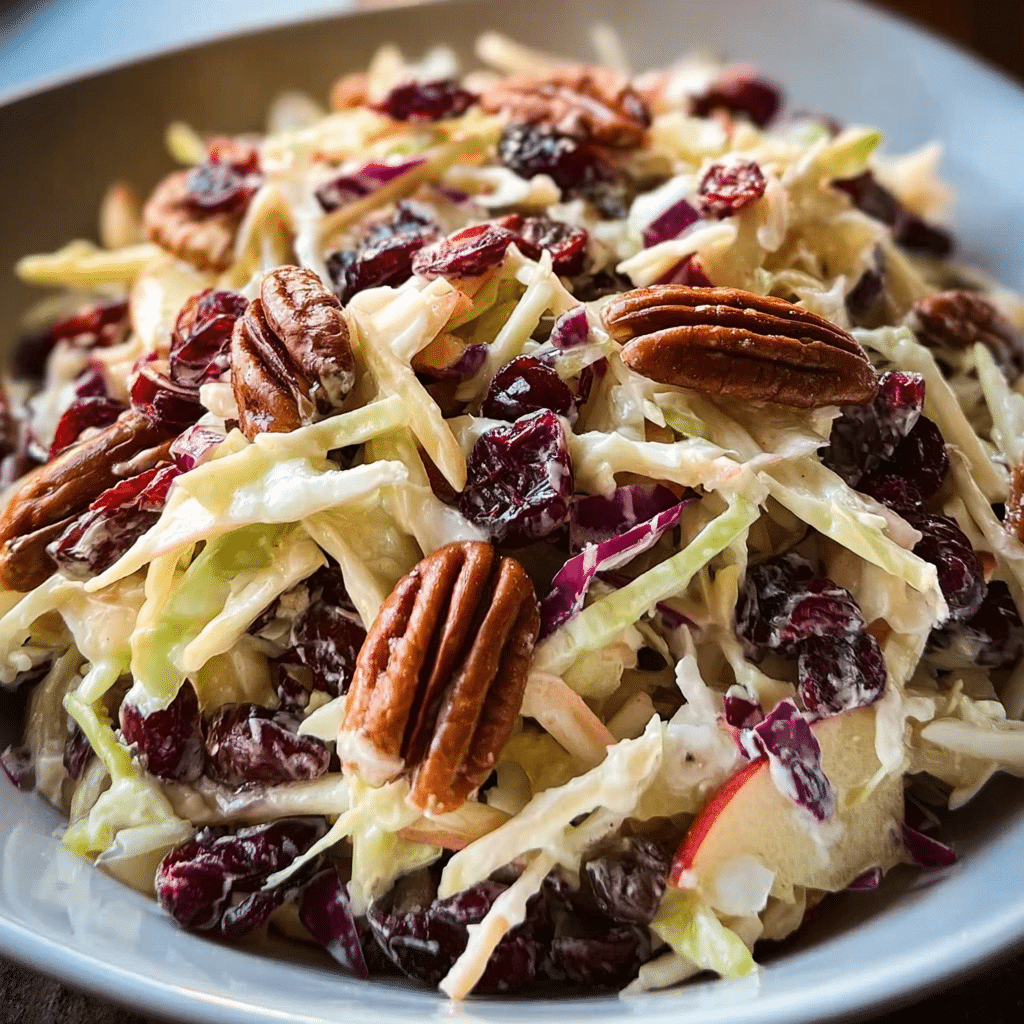Fall harvest salad is not just a dish; it’s a celebration of the season, a cornucopia of flavors and textures that brings warmth and comfort to any dining table. I remember the first time I stumbled upon this delightful recipe during a crisp autumn afternoon at my local farmer’s market. The vibrant colors of freshly harvested vegetables and fruits caught my eye, and I was instantly inspired to create something that encapsulated the essence of fall. As I gathered squash, apples, and kale, a vision of a beautiful salad began to take shape in my mind—a dish that would not only nourish but also evoke the spirit of the harvest season.

The story of my fall harvest salad begins with a family tradition. Every year, as the leaves change and the air turns brisk, my mother would gather us around the kitchen to prepare our Thanksgiving feast. Among the turkey and stuffing, there was always a special salad filled with the season’s bounty. It was a medley of flavors—sweet, savory, and tangy—that danced on our palates and brought us together as a family. This memory is what drives me to recreate that salad each autumn, putting my spin on it while still honoring the roots of that cherished dish.
The Story Behind This Recipe
When I first crafted my own version of the fall harvest salad, I wanted to pay homage to those family gatherings while infusing it with my personality and creativity. I experimented with different ingredients, finding the perfect balance between crunchy, roasted, and fresh components. I remember the first bite; the combination of roasted butternut squash, crisp apples, and peppery arugula was like a warm hug on a cool day. The tangy dressing made from apple cider vinegar and maple syrup brought everything together, highlighting the natural sweetness of the autumn produce.
What sets my fall harvest salad apart from others is not just the ingredients but the love and memories that each bite evokes. It’s a dish that tells a story and invites others to share in the experience. It’s perfect for busy families seeking quick yet nutritious dinner solutions, as it can be prepped ahead of time and served as a side or a main dish. The versatility of the salad allows for endless variations—add grilled chicken for protein, or swap out the apples for pears if you prefer. With just a little planning, it becomes a seamless addition to your busy weeknight dinners or holiday gatherings.
This salad shines particularly during the harvest months of September through November, when the produce is at its peak. It’s a dish that invites the essence of the season into your home—a way to celebrate the bounty of local farms and the transition into cooler months. The vibrant colors of the salad mirror the beautiful autumn foliage, creating a feast for the eyes as well as the taste buds.
There’s an emotional connection to the fall harvest salad that goes beyond just the ingredients. It represents gratitude for the earth’s gifts and the time spent with loved ones, whether it’s during a cozy family dinner or a festive gathering with friends. Sharing this salad feels like sharing a piece of my heart, and I hope to inspire others to create their own memories around this dish.
In this article, you will learn not only how to make the perfect fall harvest salad but also the rich history and cultural significance behind it. I’ll share tips on ingredient selection, preparation methods, and how to customize it to fit your family’s tastes. By the end, you’ll be inspired to bring this beautiful fall staple into your own home, creating your own memories and traditions around this delightful dish.
Why You’ll Love This Dish
So, why will you love this fall harvest salad? It’s simple. The combination of fresh ingredients, the ease of preparation, and the emotional ties to the season make it a dish that resonates with everyone. Whether you’re a seasoned cook or just starting out, you’ll find joy in crafting this salad that speaks to the heart of autumn. It’s a recipe that not only fills your stomach but also warms your soul, making it perfect for this time of year when we gather, celebrate, and give thanks.
The Rich History and Cultural Significance of fall harvest salad
The rich history and cultural significance of fall harvest salad are as diverse as the ingredients that make it up. This dish draws from a tradition of celebrating the bountiful harvest, which has been a central theme in many cultures throughout history. From ancient harvest festivals to modern-day Thanksgiving celebrations, the act of gathering and sharing food has always been a way to connect with others and honor the earth’s blessings.
Origins and History
The origins of the fall harvest salad can be traced back to ancient agricultural societies where the harvest was a time of great celebration. In many cultures, the autumn equinox marked a period of gratitude and reflection, where communities would come together to give thanks for the crops that sustained them through the year. This celebration often included communal meals featuring the season’s bounty—root vegetables, grains, and, of course, fresh greens. Salads, as we know them today, were a way to showcase these ingredients in a vibrant and visually appealing manner.
As the years progressed and regional cuisines developed, each culture began to infuse their unique flavors and ingredients into their versions of the harvest salad. In Mediterranean regions, for instance, salads often featured olives, feta, and seasonal vegetables, while North American versions might highlight pumpkin, apples, and nuts. The versatility of the dish allowed it to evolve, adapting to local harvests and culinary traditions.
In the United States, the fall harvest salad gained prominence during the 20th century, particularly alongside the rise of the farm-to-table movement. As more people became aware of the benefits of eating locally and seasonally, the concept of a fall harvest salad transformed from a simple side dish into a culinary centerpiece. Chefs began to experiment with new flavors and techniques, incorporating grains, proteins, and creative dressings to elevate the dish and make it a staple at holiday gatherings.
Cultural Significance
The cultural significance of the fall harvest salad is profound, as it represents not only the food itself but also the community and traditions surrounding it. In many cultures, sharing meals during harvest time is a way to strengthen bonds and express gratitude. For instance, in the U.S., Thanksgiving is a time when families gather to celebrate the harvest with a feast that often includes a variety of salads, including the beloved fall harvest salad. This dish is more than just a recipe; it is a symbol of unity, reflection, and the celebration of abundance.
Different regions have their variations of the fall harvest salad that pay tribute to local ingredients and customs. In New England, you might find roasted root vegetables and cranberries incorporated, while in the Midwest, apples and walnuts are popular additions. These regional differences enrich the dish, making it a canvas for creativity and a reflection of local culture.
Nutritional Benefits
Beyond its cultural significance, the fall harvest salad is also packed with nutritional benefits. Filled with seasonal produce like kale, sweet potatoes, and apples, this salad is a powerhouse of vitamins, minerals, and antioxidants. Kale, for instance, is known for its high vitamin K content, which supports bone health, while sweet potatoes provide a rich source of beta-carotene, which is essential for good vision and immune function.
Moreover, the inclusion of nuts and seeds adds healthy fats and protein, making the salad not only a colorful side dish but also a balanced meal option. The variety of textures—from crunchy to creamy—also ensures that every bite is a delightful experience. Whether you are looking to boost your immune system as the seasons change or simply want a fresh and delicious meal, the fall harvest salad has something for everyone.
In conclusion, the fall harvest salad is a dish steeped in history and cultural significance, embodying the spirit of gratitude and community that accompanies the harvest season. With its diverse origins and nutritional benefits, it’s a recipe that invites you to explore the bounty of autumn and create your own memories around the table. As you prepare your own version of this salad, remember that you’re not just making a meal; you’re participating in a long-standing tradition that celebrates the richness of life and the connections we share with those we love.
Essential Ingredients for Perfect fall harvest salad
Essential Ingredients for Perfect Fall Harvest Salad
When it comes to creating the ultimate fall harvest salad, the magic truly lies in the ingredients you choose. This salad isn’t just a dish; it’s a celebration of the autumn season, showcasing vibrant colors, rich flavors, and textures that evoke warmth and comfort. Below, I’ll take you through each essential ingredient, highlighting its role, how to choose the best ones, and some handy tips for preparation and storage.
Essential Ingredients
- 1/4 cup raw pecans
- 2 tablespoons pumpkin seeds
- 3 tablespoons maple syrup
- 1/2 teaspoon cayenne pepper
- 1/4 teaspoon ground cinnamon
- Flaky sea salt
- 3 ounces thinly sliced prosciutto
- 6 cups arugula or shredded kale
- 2 honeycrisp apples, thinly sliced
- 1 avocado, diced
- Arils from 1 pomegranate
- 1/2 cup crumbled feta cheese
- Apple Vinaigrette
- 1/3 cup extra virgin olive oil
- 1/4 cup apple cider vinegar
- 1 tablespoon dijon mustard
- 1 tablespoon apple butter (optional)
- 2 teaspoons honey or maple syrup
- 1 tablespoon fresh thyme leaves
- 2 teaspoons chopped fresh sage
- Kosher salt and black pepper

Fall Harvest Salad
Ingredients
- 1/4 cup raw pecans
- 2 tablespoons pumpkin seeds
- 3 tablespoons maple syrup
- 1/2 teaspoon cayenne pepper
- 1/4 teaspoon ground cinnamon
- flaky sea salt
- 3 ounces thinly sliced prosciutto
- 6 cups arugula or shredded kale
- 2 honeycrisp apples, thinly sliced
- 1 avocado, diced
- arils from 1 pomegranate
- 1/2 cup crumbled feta cheese
Apple Vinaigrette
- 1/3 cup extra virgin olive oil
- 1/4 cup apple cider vinegar
- 1 tablespoon dijon mustard
- 1 tablespoon apple butter (optional)
- 2 teaspoons honey or maple syrup
- 1 tablespoon fresh thyme leaves
- 2 teaspoons chopped fresh sage
- kosher salt and black pepper
Instructions
- Preheat the oven to 350° F. Line a baking sheet with parchment paper.
- On the prepared baking sheet, toss together the pecans, pumpkin seeds, maple, cayenne, and cinnamon. Arrange in a single layer. Lay the prosciutto flat around the nuts. Transfer to the oven and bake for 10-15 minutes or until the nuts are toasted and the prosciutto is crisp. Watch both closely. Sprinkle the nuts with sea salt.
- Meanwhile, in a large salad bowl, combine the arugula, apples, avocado, and pomegranate arils.
- To make the vinaigrette. Combine all ingredients in a jar with a lid and shake. Taste and adjust as needed.
- Pour the vinaigrette over the salad, tossing to combine. Top the salad with toasted nuts, prosciutto, and feta. Eat and enjoy!
Every ingredient in this fall harvest salad has a purpose, contributing to the overall experience. Let’s dive deeper into why these ingredients are essential and how to select the best options.
Pecans and Pumpkin Seeds
The crunch of raw pecans and pumpkin seeds adds a satisfying texture. Look for pecans that are plump and smell nutty. Freshness is key, as stale nuts can ruin the flavor. If you can, buy them from bulk bins and store them in an airtight container in the fridge to maintain their crunch. Pumpkin seeds, or pepitas, should have a vibrant green color. They’re often sold raw or roasted, but for this salad, raw is best to retain their natural flavor.
Sweet and Spicy Elements
Maple syrup brings a natural sweetness to balance the earthy flavors, and it’s a quintessential fall ingredient. Opt for pure maple syrup rather than imitation for the best flavor. The cayenne pepper adds a subtle heat that’s beautifully complemented by the warm notes of ground cinnamon. Both of these spices should be fresh; check the labels for the date to ensure they haven’t lost their potency.
Prosciutto and Greens
The thinly sliced prosciutto introduces a savory richness that harmonizes perfectly with the salad’s sweetness. When selecting prosciutto, look for a good-quality product that has a delicate, slightly sweet flavor and a lovely marbled appearance. For the greens, arugula delivers a peppery bite, while kale offers sturdiness and a heartier texture. Both are available in the fall, making them perfect for your fall harvest salad. When buying greens, choose vibrant, crisp leaves without any signs of wilting.
Fruits and Feta
Honeycrisp apples are renowned for their crisp texture and sweet-tart flavor, making them a fantastic addition. Choose apples that are firm, with no soft spots. The creamy avocado adds richness, while the pomegranate arils provide bursts of juicy sweetness. For the feta cheese, opt for a block of cheese rather than crumbled for better flavor and texture; crumbling just before serving will keep it fresher.
Apple Vinaigrette
The homemade apple vinaigrette ties everything together. Using high-quality extra virgin olive oil and apple cider vinegar is crucial for a delicious dressing. The dijon mustard adds a tangy depth, while apple butter, if used, enhances the sweetness. Fresh herbs like thyme and sage not only add flavor but also a wonderful aroma that evokes fall. Select herbs that are vibrant and fragrant for the best results.
Shopping Tips
When shopping for your fall harvest salad ingredients, consider visiting local farmers’ markets. They often offer seasonal produce that is fresher than what you might find in grocery stores. Look for organic options when possible, particularly for apples and greens, as they tend to be less pesticide-laden. If you’re on a budget, buying in bulk can save you money, especially for nuts and seeds.
Substitutions and Alternatives
If you have dietary restrictions or preferences, there are plenty of substitutions. For a vegan version, you can replace prosciutto with marinated tofu or chickpeas for added protein. If you’re avoiding dairy, try using a vegan feta cheese or simply omit it. For those who prefer a milder salad, you can skip the cayenne pepper or adjust the amount to suit your taste.
Storage is also essential; keep your pecans and pumpkin seeds in a cool, dark place, and store your greens in a damp paper towel in a plastic bag to prolong freshness. Apples should be kept in the fridge, while pomegranate arils can be stored in an airtight container for a week. With these tips in mind, you’re well on your way to assembling a delicious and vibrant fall harvest salad!
Detailed Step-by-Step fall harvest salad Cooking Instructions
Detailed Step-by-Step Fall Harvest Salad Cooking Instructions
Creating a stunning fall harvest salad is not only about the ingredients; it’s also about the technique and presentation. In this section, I will guide you through each step to ensure your salad is both beautiful and delicious. With a little preparation and some culinary finesse, you’ll have a dish that not only tastes great but looks equally impressive.
Preparation Steps
- Gather Your Ingredients: Start by assembling all your ingredients on your kitchen counter. This practice, known as mise en place, will make the cooking process smoother and more enjoyable.
- Toast the Nuts: In a dry skillet over medium heat, add the raw pecans and pumpkin seeds. Toast them for about 3-5 minutes, stirring frequently until they become fragrant and slightly golden. Keep a close eye on them; nuts can burn quickly if left unattended.
- Prepare the Dressing: In a small bowl, whisk together the extra virgin olive oil, apple cider vinegar, dijon mustard, honey or maple syrup, and apple butter (if using). Add the fresh thyme leaves, chopped sage, and season with kosher salt and black pepper. Taste and adjust the seasoning or sweetness to your preference.
- Slice the Prosciutto: Using a sharp knife, thinly slice the prosciutto into strips. If you prefer smaller pieces, you can chop them into bite-sized squares.
Cooking Process
- Prepare the Greens: In a large mixing bowl, add your arugula or shredded kale. If using kale, it’s beneficial to massage the leaves gently with a bit of olive oil and salt to soften them and enhance their flavor.
- Slice the Apples: Core and thinly slice the honeycrisp apples. To prevent browning, you can toss them in a little lemon juice or simply add them to the salad right away.
- Dice the Avocado: Cut the avocado in half, remove the pit, and scoop the flesh out with a spoon. Dice it into bite-sized pieces.
- Prepare the Pomegranate: Cut the pomegranate in half and gently tap the back with a wooden spoon to release the arils. This can be a messy process, so doing it over a bowl can help catch any juice that escapes.
Final Assembly
- Combine Ingredients: In the bowl with the greens, add the sliced apples, diced avocado, pomegranate arils, toasted nuts, and prosciutto. Gently toss to combine.
- Add Feta: Sprinkle the crumbled feta cheese over the top. This is a great time to take a moment to appreciate how beautiful your salad looks with all the vibrant colors!
- Dress the Salad: Drizzle the prepared apple vinaigrette over the salad and toss gently to coat all the ingredients evenly. Be careful not to overmix; you want everything to stay intact and visually appealing.
- Let It Rest: Allow the salad to sit for about 5 minutes before serving. This will give the flavors time to meld together beautifully.
- Serve and Enjoy: Serve your fall harvest salad in a large bowl or on individual plates. Garnish with extra pomegranate arils or a sprinkle of flaky sea salt for that final touch. Enjoy every bite!
In conclusion, this fall harvest salad is a delightful way to embrace the flavors of the season. Each step of the preparation and cooking process contributes to creating a dish that’s not only healthy and satisfying but also visually stunning. Remember to take your time with the assembly, as the presentation is just as important as the taste. With the right ingredients and a little love, your fall harvest salad will surely impress family and friends alike!
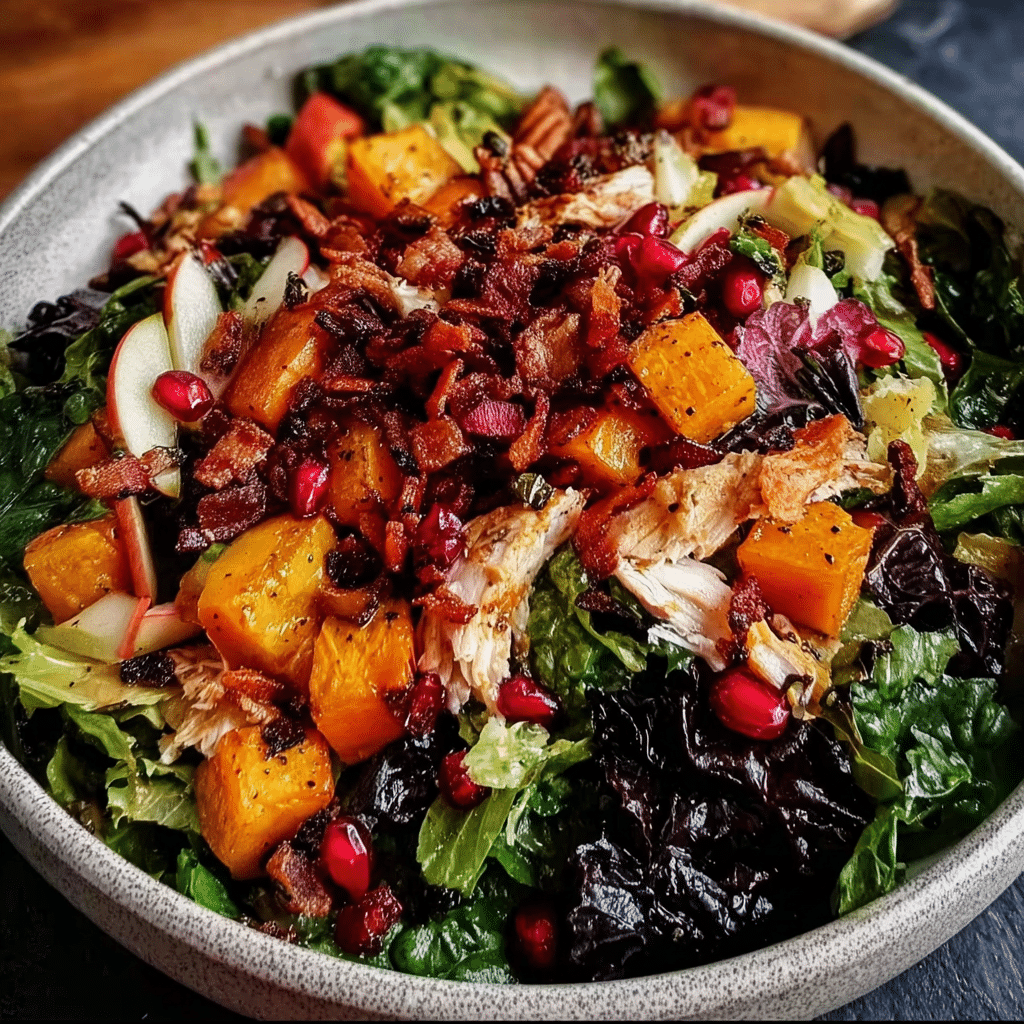
Professional Tips and Techniques for fall harvest salad
When it comes to creating the perfect fall harvest salad, there’s an art to mastering the balance of flavors, textures, and visual appeal. It’s not just about throwing together a mix of ingredients; it’s about showcasing the vibrant bounty of the season. Here, I’ll share some professional tips and techniques that will elevate your fall harvest salad from good to unforgettable.
Professional Techniques
One of the first things to consider when preparing your fall harvest salad is the freshness and quality of your ingredients. Opt for organic, seasonal produce when possible. Think of ingredients like butternut squash, Brussels sprouts, apples, and pecans. Roasting vegetables can enhance their natural sweetness, which is a fantastic technique for a fall harvest salad. Simply toss your chopped veggies in olive oil, salt, and pepper, and roast them at 400°F for 20-25 minutes until they are tender and caramelized.
Another secret to achieving a delightful harmony of flavors lies in the dressing. A well-balanced vinaigrette can elevate even the most basic ingredients. For a fall harvest salad, consider a maple-Dijon vinaigrette. Combine equal parts of maple syrup and apple cider vinegar, whisk in Dijon mustard, and slowly drizzle in olive oil. This dressing not only complements the earthy flavors of your salad but also adds a hint of sweetness that captures the essence of autumn.
Don’t forget about the texture! Incorporating a variety of textures will make each bite an adventure. For instance, crunchy nuts or seeds can contrast beautifully with soft roasted vegetables and crisp greens. A handful of toasted pumpkin seeds or candied pecans can add that much-needed crunch while also bringing in seasonal flavors.
Troubleshooting Guide
Even seasoned cooks can run into hurdles while creating their fall harvest salad. One common issue is wilting greens. To avoid this, ensure your greens are thoroughly dried after washing. Use a salad spinner or simply lay them out on a clean kitchen towel. If you find that your salad is too oily or too dry, adjust your dressing accordingly. Always dress your salad lightly and taste as you go to prevent overpowering the other flavors.
Another potential pitfall is overcooking your roasted vegetables. Keep an eye on them, as the cooking time can vary based on size and type. If they start to char too much, it can introduce a bitter flavor. Aim for golden-brown edges for that perfect balance of sweetness and savoriness.
Presentation Tips
Presentation is key in making your fall harvest salad appealing. Consider using a large wooden bowl for a rustic feel or a clear glass bowl to showcase the vibrant colors of your ingredients. Layering your ingredients can create visual interest; start with a base of greens, then add roasted vegetables, fruits, and nuts, finishing with your dressing drizzled on top.
To add an extra touch, you can garnish your salad with edible flowers or fresh herbs like parsley or thyme. Not only do they add color, but they also provide a burst of flavor that can brighten your dish. When serving, try to present individual portions on plates or in jars for a trendy, on-the-go option.
Wine and Beverage Pairings
Pairing your fall harvest salad with the right beverage can enhance your dining experience. A crisp, dry white wine such as Sauvignon Blanc can complement the acidity of the dressing while balancing the sweetness of the roasted vegetables. For those who prefer red wine, a light-bodied Pinot Noir works wonderfully, as its berry notes can harmonize with the salad’s ingredients.
If you’re looking for non-alcoholic options, consider a sparkling apple cider or a spiced chai tea. Both beverages can bring out the autumnal flavors of your salad and offer a refreshing contrast to the richness of the ingredients.
In conclusion, creating a fall harvest salad is a delightful journey through the season’s flavors. With the right techniques, troubleshooting strategies, and an eye for presentation, you can craft a salad that not only tastes incredible but also looks stunning on the table. So roll up your sleeves, gather your ingredients, and let’s bring the essence of fall to your dining experience!
Creative Variations and Adaptations of fall harvest salad
The beauty of a fall harvest salad lies in its versatility. With an abundance of seasonal ingredients at your fingertips, there are countless creative variations and adaptations to explore. Whether you’re looking to cater to specific dietary needs or simply want to try something new, the possibilities are endless. Let’s dive into some exciting ways to make your fall harvest salad uniquely yours!
Seasonal Variations
While traditional ingredients like roasted squash, apples, and nuts are staples of a fall harvest salad, don’t hesitate to experiment with seasonal swaps. For instance, substitute roasted sweet potatoes for butternut squash for a slightly different flavor profile. Kale can be used instead of mixed greens for a sturdier base that holds up well against heavier toppings.
Incorporating seasonal fruits like pears or pomegranates can add a delightful sweetness and a pop of color. Pears can be sliced thinly and added raw for crunch, while pomegranate seeds can be sprinkled on top for a burst of tartness. Additionally, consider using roasted root vegetables such as carrots or parsnips, which are also abundant in the fall.
Dietary Adaptations
In today’s culinary landscape, accommodating various dietary needs has become increasingly important. Thankfully, a fall harvest salad can easily be adapted to fit a range of preferences. For a keto-friendly version, focus on leafy greens, avocado, and seeds while omitting higher-carb ingredients like apples. For a vegan twist, swap out any cheese for avocado or tahini dressing, which can also provide a creamy texture.
If gluten is a concern, simply ensure that any grains or croutons used are gluten-free. Quinoa or wild rice can serve as excellent gluten-free bases that also add heartiness to your salad. Those following a paleo diet can enjoy a fall harvest salad by sticking to whole, unprocessed ingredients and avoiding grains and legumes.
Creative Twists
Why not take inspiration from international cuisines to give your fall harvest salad a unique flair? For a Mediterranean twist, incorporate roasted eggplant, feta cheese, and a drizzle of tahini dressing. Alternatively, an Asian-inspired version could include shredded cabbage, mandarin oranges, and a sesame ginger dressing.
Another fun idea is to incorporate unexpected spices to elevate your fall harvest salad. A dash of cinnamon or nutmeg can add warmth, while a sprinkle of chili flakes can provide a surprising kick. Experiment with different cooking methods as well; consider grilling your vegetables instead of roasting them for a smoky flavor or even using a slow cooker to prepare a warm salad.
Lastly, let’s not forget those delicious leftovers! Transform any remaining salad into a flavorful wrap by placing it in a tortilla or lettuce leaf and adding your choice of protein. Alternatively, blend it into a soup for a comforting fall meal.
In conclusion, the fall harvest salad is a canvas for creativity. With seasonal ingredient swaps, dietary adaptations, and international twists, you can craft a salad that not only showcases the beauty of autumn but also caters to your personal tastes and preferences. So, gather your ingredients, embrace the season, and let your culinary creativity shine!
Storage, Reheating, and Meal Prep for fall harvest salad
When it comes to creating a delightful fall harvest salad, not only is it important to focus on the freshness and quality of the ingredients, but also on how to store it properly to maintain its vibrant flavors and textures. In my experience, I’ve learned that proper storage can make or break your salad adventure, especially when you’re preparing meals ahead of time or trying to save leftovers. Let’s dive deep into the various storage methods, reheating techniques, meal prep strategies, and food safety considerations for your fall harvest salad.
Short-term Storage
After assembling your fall harvest salad, it’s essential to store it correctly to ensure that it remains fresh and appetizing. If you plan to eat the salad within a day or two, refrigerating it is your best option. I recommend using airtight containers that are BPA-free for optimal freshness. Glass containers with tight-fitting lids are fantastic because they don’t stain or retain odors, and they’re easy to clean. If you’re using plastic containers, make sure they’re designed for food storage to avoid any leaks.
One important tip I’ve learned is to store salads without dressing until you’re ready to eat. This technique prevents sogginess; leafy greens can wilt quickly when mixed with dressings. Instead, keep the dressing in a separate container and mix it just before serving. If you’re using hearty ingredients like roasted squash or nuts, those can be added in advance as they don’t compromise the texture of the salad.
Freezing and Long-term Storage
While I wouldn’t recommend freezing a fully assembled fall harvest salad, you can certainly prepare individual components ahead of time for later use. For instance, roasted vegetables like butternut squash or Brussels sprouts freeze beautifully. Simply roast them as you normally would, let them cool completely, and then store them in freezer-safe bags or containers. When you’re ready to enjoy your salad, you can thaw them in the refrigerator overnight for the best results.
Fruits, such as apples or pears, can also be chopped and frozen, but keep in mind that their texture may change once thawed. A great alternative is to slice them fresh and add them to the salad right before serving. This way, you preserve their crunch and juiciness.
As for greens, freezing isn’t ideal. When thawed, they often become limp and unappetizing. Instead, consider pre-washing and drying the greens, storing them in a damp paper towel inside an airtight container in the fridge. This will keep them fresh for a few extra days.
Reheating Best Practices
If you happen to have leftover components of your fall harvest salad that require reheating, it’s important to do so gently to retain quality. For roasted vegetables, using the oven is a great method. Preheat your oven to about 350°F (175°C), spread the vegetables on a baking sheet, and heat for 10-15 minutes or until warmed through. This method helps maintain their crispiness.
Alternatively, you can use a microwave, but be cautious! Heat the vegetables in short bursts of 30 seconds, stirring in between to ensure even heating. Microwaving can sometimes lead to sogginess, so keep an eye on them.
When it comes to grains like quinoa or farro that might be included in your salad, they can also be reheated in the microwave or on the stovetop with a splash of water to prevent drying out. The key is to monitor the temperature and not overheat, as this can change their texture.
Food safety is a vital consideration in any meal prep. Always cool down your salad components quickly before storing them in the refrigerator or freezer. Ensure that your refrigerator is set to 40°F (4°C) or below, and consume leftovers within 3-4 days for optimal freshness. If you’re ever in doubt about the safety of your food, it’s best to err on the side of caution and discard it.
Lastly, when it comes to portioning your fall harvest salad, consider using smaller containers for individual servings. This way, you can easily grab a healthy lunch to go, and it also helps to minimize waste. Plus, it looks appealing to have neatly organized meals awaiting you in the fridge!
In summary, proper storage and reheating techniques for your fall harvest salad can greatly enhance your meal prep experience. By taking the time to store ingredients separately, utilizing appropriate containers, and being mindful of food safety, you’ll ensure that every bite of your salad remains fresh, flavorful, and enjoyable.
Nutritional Benefits and Health Information
The fall harvest salad isn’t just a feast for the eyes; it’s a powerhouse of nutritional benefits packed into a single bowl. As the leaves turn and the air grows crisp, I find myself reaching for seasonal ingredients that not only taste delicious but also nourish my body. In this section, we’ll explore the nutritional breakdown of this delightful salad, the health benefits of its key ingredients, and how it can fit into various dietary plans.
Nutritional Profile
Let’s break down the nutritional components of a typical fall harvest salad. While the exact values will vary depending on the specific ingredients and quantities you use, a well-rounded fall harvest salad usually includes a mix of greens, roasted vegetables, nuts, seeds, and a light dressing. On average, a serving of this salad can range around 150-300 calories, depending on the add-ins.
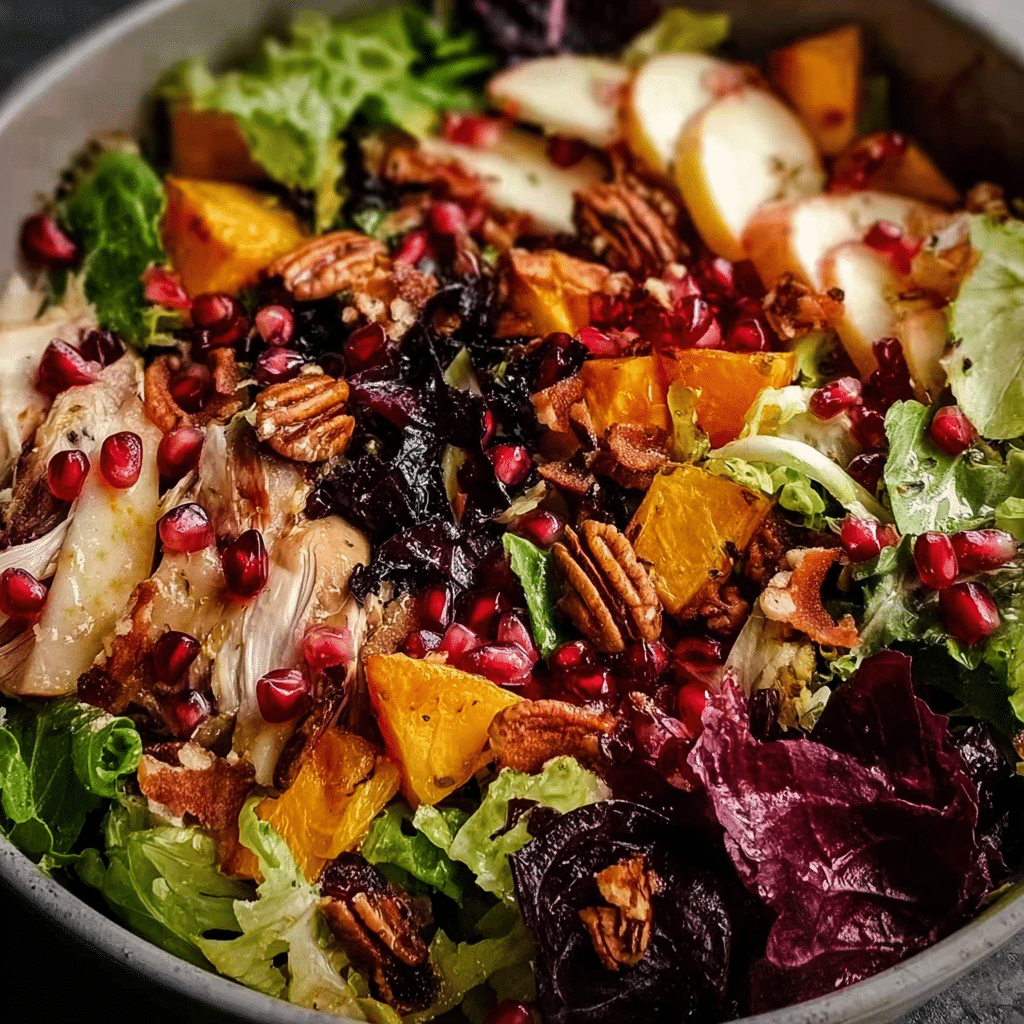
Key ingredients often include leafy greens like kale or spinach, which are low in calories but high in vitamins A, C, and K. Roasted vegetables such as butternut squash provide healthy carbohydrates, fiber, and essential nutrients like potassium and magnesium. Nuts and seeds, often sprinkled on top for crunch, offer healthy fats, protein, and a variety of vitamins and minerals. For instance, walnuts are rich in omega-3 fatty acids, while pumpkin seeds provide zinc and iron.
When you combine these ingredients, you create a salad that is not only satisfying but also nutrient-dense. It’s a great way to incorporate a wide range of vitamins, minerals, and antioxidants into your diet, promoting overall health and wellness.
Health Benefits
The health benefits of a fall harvest salad are numerous. Firstly, the abundance of vegetables and greens offers a significant amount of fiber, which is essential for digestive health. Fiber helps to keep you full longer, which can aid in weight management. Additionally, the vitamins and minerals found in leafy greens and roasted veggies support a healthy immune system, especially during the colder months when colds and flu are more prevalent.
Moreover, many ingredients in a fall harvest salad, like sweet potatoes and carrots, are rich in beta-carotene, which converts to vitamin A in the body. This nutrient is crucial for maintaining healthy vision, skin, and immune function. The nuts and seeds provide not only crunch but also heart-healthy fats that can help lower bad cholesterol levels.
Another notable aspect is the inclusion of seasonal fruits like apples or pears, which add natural sweetness and contain antioxidants that combat oxidative stress in the body. These fruits are particularly beneficial in the fall, as they are in season and packed with flavor.
Dietary Considerations
When crafting your fall harvest salad, it’s essential to consider dietary restrictions and allergen information. This versatile dish can easily be modified to cater to various dietary needs, making it a crowd-pleaser for gatherings. For those following a vegan or vegetarian diet, the salad can be made entirely plant-based by omitting any meat or dairy products. You can also substitute traditional dressings with vinaigrettes made from olive oil and vinegar for a healthier option.
If you’re looking to reduce calories or fat, consider using less dressing or opting for a yogurt-based dressing, which offers creaminess without the added calories. For gluten-sensitive individuals, ensure that any grains used, such as quinoa, are certified gluten-free, as cross-contamination can sometimes occur.
In summary, the fall harvest salad is not only a celebration of seasonal produce but also a nutritious addition to your diet. With its rich array of vitamins, minerals, and healthy fats, it supports a healthy lifestyle while being adaptable to various dietary preferences. So, whether you’re enjoying it as a light lunch or a hearty side dish, you can feel good knowing you’re nourishing your body with every bite.
Frequently Asked Questions About Fall Harvest Salad
Fall harvest salad with chicken
A fall harvest salad with chicken is a nutritious and satisfying meal option, combining seasonal ingredients with protein. To make this salad, start with mixed greens as your base, then add grilled or roasted chicken breast for protein. Incorporate seasonal vegetables such as roasted Brussels sprouts, apples, or pears for sweetness and crunch. For added texture, consider incorporating nuts like walnuts or pecans. Drizzle with a tangy vinaigrette to enhance the flavors and enjoy a hearty, balanced salad perfect for fall.
Roasted fall harvest salad
A roasted fall harvest salad is a delightful way to showcase the rich flavors of autumn vegetables. Begin by roasting root vegetables like carrots, sweet potatoes, and beets until tender and caramelized. Toss these warm vegetables on a bed of mixed greens, adding ingredients like goat cheese or feta for creaminess. Dried cranberries or pomegranate seeds can provide a burst of sweetness, while nuts add a satisfying crunch. Serve this salad warm with a simple olive oil and balsamic vinegar dressing to bring it all together.
Fall harvest salad recipe
Creating a fall harvest salad is simple and rewarding, combining a variety of flavors and textures. Start with a base of kale or spinach, and layer in roasted seasonal vegetables like butternut squash, Brussels sprouts, and roasted beets. Add in some sliced apples or pears for sweetness, along with a handful of nuts such as pecans or walnuts for added crunch. Toss the salad with a homemade dressing made from olive oil, apple cider vinegar, and a touch of maple syrup for a sweet finish. This salad not only looks vibrant but also provides a wholesome meal.
Fall harvest salad dressing
The right dressing can elevate your fall harvest salad, complementing the earthy flavors of the seasonal ingredients. A simple and delicious dressing features olive oil, apple cider vinegar, Dijon mustard, and a touch of maple syrup or honey for sweetness. Whisk these ingredients together until emulsified, and adjust the seasoning with salt and pepper to taste. For a creamier option, consider adding Greek yogurt or tahini to the mix. This dressing pairs beautifully with roasted vegetables and fresh fruits, enhancing the overall flavor profile of the salad.
Easy harvest salad recipe
An easy harvest salad recipe can be both quick to prepare and full of seasonal flavors. Start with pre-washed greens like arugula or mixed salad greens as your base. Add simple ingredients such as diced apples, roasted pumpkin seeds, and shredded carrots for color and crunch. Toss everything together with a store-bought vinaigrette or a quick homemade dressing made from olive oil, vinegar, and your choice of herbs. This salad is perfect for busy weeknights and can be customized with whatever seasonal ingredients you have on hand.
Fall harvest salad butternut squash
Incorporating butternut squash into your fall harvest salad adds a delightful sweetness and creamy texture. Start by peeling and cubing the squash, then roast it in the oven with olive oil, salt, and pepper until golden and tender. Once cooled, mix the roasted squash with leafy greens, dried cranberries, and crumbled feta or goat cheese. For added crunch, sprinkle some pumpkin seeds on top, and finish with a maple-balsamic dressing to tie all the flavors together. This salad is not only visually appealing but also packed with nutrients.
Fall harvest salad with sweet potato
A fall harvest salad with sweet potato is a delicious and hearty option that highlights the flavors of the season. Begin by roasting cubed sweet potatoes tossed in olive oil, salt, and spices like cinnamon or smoked paprika until they are tender and caramelized. Combine the roasted sweet potatoes with greens like spinach or kale, along with ingredients such as black beans, corn, and diced red onion for a Southwestern twist. Add a zesty lime vinaigrette for a refreshing contrast to the sweetness of the potatoes. This salad is filling and perfect for a nutritious lunch or dinner.
Harvest salad dressing
A great harvest salad dressing enhances the robust flavors of seasonal ingredients and can easily be made at home. A classic option includes olive oil, apple cider vinegar, Dijon mustard, and maple syrup, whisked together until emulsified. For a different flavor profile, consider adding fresh herbs like thyme or rosemary, which complement the earthy taste of fall produce. If you prefer a creamier dressing, mix in Greek yogurt or tahini for added richness. This dressing can be stored in the fridge for up to a week, making it convenient for multiple meals.
Conclusion: Mastering the Perfect fall harvest salad
Creating the perfect fall harvest salad is more than just following a recipe—it’s about understanding the techniques, ingredients, and cultural significance behind this beloved dish. Throughout this comprehensive guide, we’ve explored everything from the historical origins to modern variations, ensuring you have all the knowledge needed to make this recipe your own.
Whether you’re a beginner cook or an experienced chef, the techniques and tips we’ve shared will help you create a fall harvest salad that’s not only delicious but also meaningful. Remember that cooking is a journey of discovery, and each time you make this dish, you’ll learn something new.
We encourage you to experiment with the variations we’ve discussed, adapt the recipe to your dietary needs, and most importantly, share it with the people you love. Food has the incredible power to bring people together, and Fall Harvest Salad is the perfect dish to create lasting memories around your dinner table.

